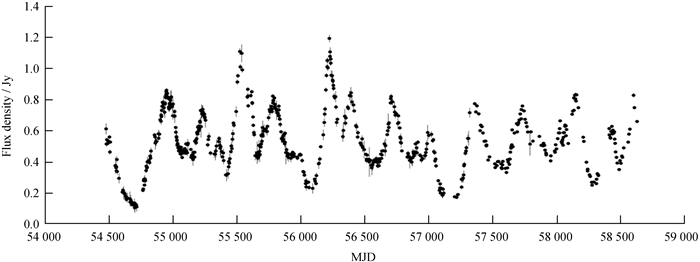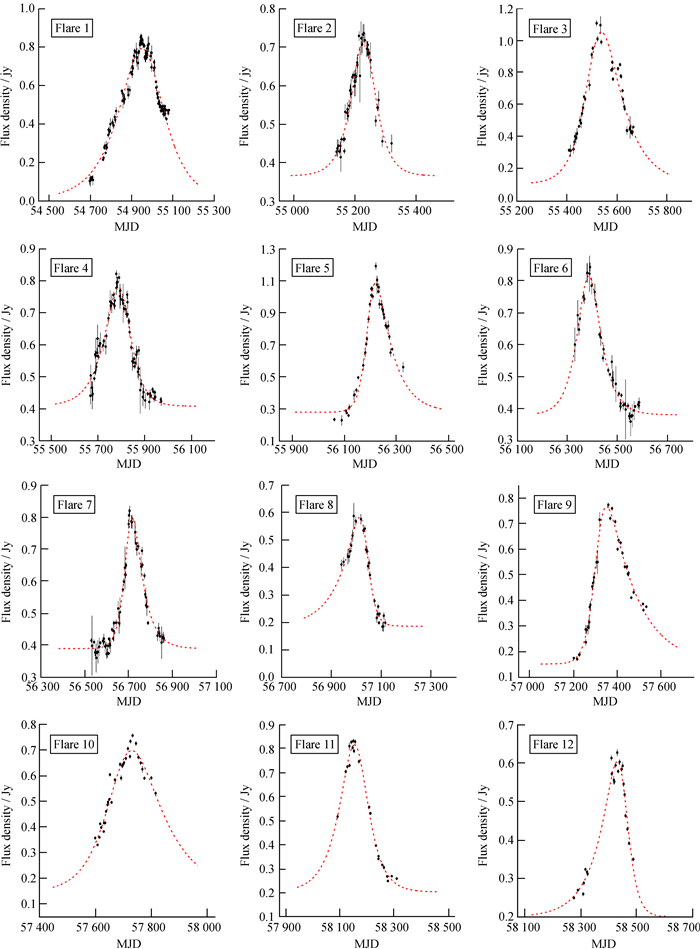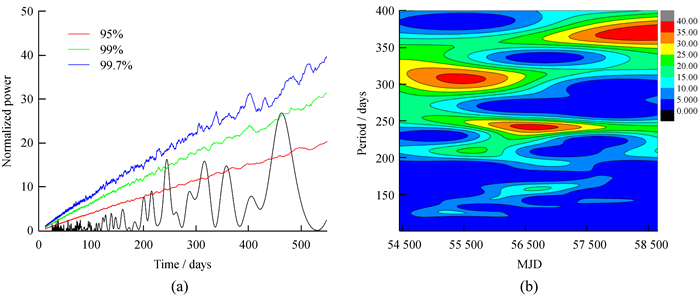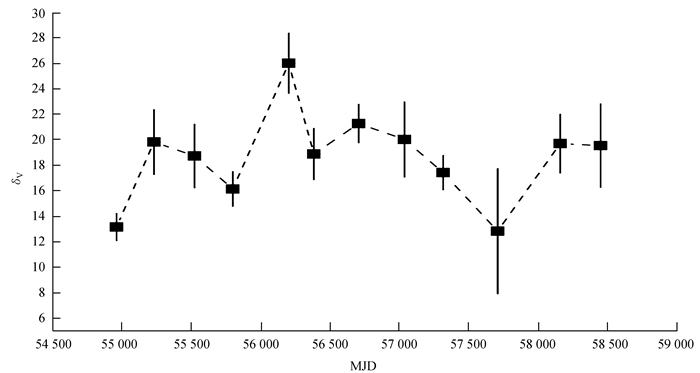耀变体(Blazar)是一类喷流与视线方向近似平行的活动星系核,其观测特征包括宽波段电磁辐射、高光度、高偏振、视超光速运动等[1]。耀变体包括平谱射电类星体(Flat Spectrum Radio Quasars, FSRQs)和蝎虎型天体(BL Lacertae Objects)两个子类,两者的差别主要体现在光谱中有无宽发射线[1]。普遍认为,耀变体在几乎整个电磁波段表现出各种时标(从几分钟到几年量级不等)的光变,少数耀变体表现出周期性光变现象[2-5]。光变研究一直是探索耀变体内部辐射过程和物理机制的最有效手段之一。由于耀变体喷流方向与观测视线之间的夹角小(θ<10°),耀变体的辐射因多普勒效应而增强[1, 6]。多普勒因子(δ)可以通过喷流中物质流速度(β)以及视角(θ)两个本征参数定义。然而这两个量都是不可直接观测的量,因此,有必要用新的其他方法估算多普勒因子。在各种估算多普勒因子的方法中,通过射电光变估算多普勒因子(δV)的方法相对比较简单,因而被广泛应用[7-10]。
B3 0307 + 380(RA=47.707 8°,Dec=38.248 3°)是一个被探测到伽马射线辐射的平谱射电类星体[11],红移z=0.816。本文利用欧文斯谷射电天文台[12]的15 GHz长时间监测数据(观测时长约11.4年,观测时间从2008年1月8日到2019年5月25日),研究B3 0307 + 380的射电光变,估算射电亮温度和光变多普勒因子,并考察是否存在周期性光变。采用的宇宙学参数为H0=73 km·s-1·Mpc-1,Ωmatter=0.27,Ωvacuum=0.73。
1 数据从欧文斯谷射电天文台官网(http://www.astro.caltech.edu/ovroblazars/)获取了B3 0307 + 380的15 GHz长时间测光数据。去除少量的坏点后,采用的测光数据包括664个点,约化儒略日MJD范围约为54 473~58 628。图 1给出了光变曲线,横坐标为MJD,纵坐标为以Jy为单位的15 GHz流量及误差(大部分误差很小,无法在图中分辨)。

|
| 图 1 B3 0307 + 380的15 GHz光变曲线 Fig. 1 The 15GHz light curve of B3 0307 + 380 |
基于光变时标限定的尺度,文[13]给出了耀变体亮温度的计算公式:
| $T_{\mathrm{b}}=\left(4.5 \times 10^{10}\right) \Delta F\left[\frac{\lambda D}{t_{\mathrm{ob}}(1+z)}\right]^{2} \mathrm{K}, $ | (1) |
其中,Tb为亮温度;ΔF为以Jy为单位的流量变化值(光变幅度);tob为以天为单位的光变时标;λ为以cm为单位的观测波长;D为以Mpc为单位的光度距离。
图 1显示B3 0307 + 380的射电光变曲线中表现出多个爆发过程。从中挑选12个包含上升和下降阶段的完整爆发过程,采用文[14]提供的双指数函数公式拟合这12个爆发过程。具体公式如下:
| $ F(t)=F_{\mathrm{c}}+F_{0}\left(\mathrm{e}^{\frac{t_{0}-t}{t_{\mathrm{r}}}}+\mathrm{e}^{\frac{t-t_{0}}{t_{\mathrm{d}}}}\right)^{-1}, $ | (2) |
其中,Fc为基底流量;t0为峰对应的时间;tr和td分别为指数上升时标和下降时标;F0为爆发的幅度。
利用基于Python语言的LMFIT程序包进行非线性最小二乘拟合,调用函数leastsq(),详情参考https://lmfit.github.io/lmfit-py/。拟合的基本原理是使观测流量值f(ti)与函数推断流量值F(ti)的残差平方和达到最小,
12个爆发过程的拟合详情和参数见图 2和表 1。第1列为爆发的序号;第2列为爆发对应的约化儒略日范围;第3列为观测点个数N;第4列为拟合所得的约化最小残差平方和
| $ \delta_{\mathrm{V}}=\left(\frac{T_{\mathrm{b}}}{T_{\mathrm{eq}}}\right)^{1 / 3}. $ | (3) |

|
| 图 2 12个爆发过程的曲线拟合 Fig. 2 Curve fitting of twelve flares |
| No. | MJD range | N |
|
t0 | Fc | F0 | tr | td |
| 1 | 54 696.4~55 080.4 | 106 | 1.73E-03 | 54 958.98±10.53 | 0.01±0.05 | 1.56±0.08 | 106.61±13.14 | 87.94±6.25 |
| 2 | 55 139.2~55 319.8 | 44 | 7.42E-04 | 55 228.74±5.75 | 0.37±0.03 | 0.71±0.05 | 36.19±6.22 | 34.29±4.89 |
| 3 | 55 409.5~55 665.8 | 41 | 3.91E-03 | 55 521.03±8.63 | 0.11±0.09 | 1.82±0.17 | 47.24±7.54 | 84.41±12.07 |
| 4 | 55 666.8~55 969.9 | 74 | 9.87E-04 | 55 797.15±5.91 | 0.41±0.01 | 0.73±0.03 | 60.11±5.28 | 40.34±4.84 |
| 5 | 56 060.9~56 325.9 | 38 | 1.84E-03 | 56 201.10±3.22 | 0.28±0.02 | 1.41±0.08 | 20.86±2.36 | 64.36±6.19 |
| 6 | 56 330.3~56 586.5 | 42 | 5.78E-04 | 56 382.04±7.73 | 0.38±0.01 | 0.86±0.02 | 39.05±6.16 | 44.63±6.12 |
| 7 | 56 529.4~56 859.5 | 61 | 6.44E-04 | 56 704.68±3.50 | 0.39±0.01 | 0.78±0.03 | 25.01±2.29 | 47.10±3.75 |
| 8 | 56 941.3~57 115.8 | 27 | 5.53E-04 | 57 035.45±4.46 | 0.19±0.02 | 0.65±0.07 | 79.13±12.44 | 19.22±3.28 |
| 9 | 57 200.6~57 531.7 | 35 | 7.28E-04 | 57 313.57±3.28 | 0.15±0.02 | 0.98±0.05 | 27.96±2.71 | 132.94±9.36 |
| 10 | 57 597.8~57 813.2 | 32 | 1.14E-03 | 57 706.77±27.12 | 0.15±0.17 | 1.07±0.39 | 65.35±30.74 | 110.41±30.88 |
| 11 | 58 090.2~58 309.5 | 22 | 5.61E-04 | 58 157.86±8.50 | 0.20±0.03 | 1.22±0.06 | 52.55±7.67 | 41.70±6.46 |
| 12 | 58 276.7~58 488.3 | 23 | 6.59E-04 | 58 449.49±7.22 | 0.20±0.05 | 0.72±0.06 | 67.12±20.63 | 23.44±3.77 |
图 3给出了多普勒因子δV的分布情况。δV的值分布在(9.12 ± 0.58)~(35.38 ± 3.34),平均值为18.65 ± 7.11 (sd),中值约为18.14。

|
| 图 3 光变多普勒因子δV的分布 Fig. 3 The distribution of variability Doppler factor δV |
历史文献中不断有关于耀变体周期性光变的报道[18-19]。耀变体的周期性光变研究,对理解其内部辐射的物理机制和辐射区的几何性质有重要意义。目前,比较常用的周期分析方法有Lomb-Scargle周期图方法[20-21]和加权小波分析方法[22]等。利用这两种方法探索了B3 0307 + 380的15 GHz光变曲线是否存在周期光变,结果列于图 4。图 4(a)为Lomb-Scargle周期图方法的分析结果,图中按照文[23]提供的基于红噪声的蒙特卡洛方法给出了95%、99%、99.7%置信度曲线。结果可看出,存在一个约244 ± 11天的>99%置信度的周期,同时也存在一个约465 ± 40天的>99%置信度的周期,后者大约为前者的两倍。图 4(b)为加权小波分析结果,图中大致可以看出,存在一个大约250天的周期,并且这个周期基本持续,特别是在观测时间的中段。

|
| 图 4 (a) Lomb-Scargle周期分析结果;(b)加权小波周期分析结果 Fig. 4 (a) The results of LSP; (b) WWZ period analysis |
耀变体光变曲线的主要特征是在多波段呈现大幅快速光变且存在高偏振。通常认为,相对论性喷流的聚束效应是导致这些极端观测特征出现的原因。欧文斯谷射电天文台的长时间监测数据显示,平谱射电类星体B3 0307 + 380的15 GHz射电光变曲线中表现出多个爆发过程。利用双指数函数拟合了12个爆发过程,得出光变多普勒因子分布在(9.12 ± 0.58)~(35.38 ± 3.34)范围内,平均值为18.65 ± 7.11 (sd)。这表明B3 0307 + 380的射电辐射存在显著的多普勒增亮效应,支持被广泛接受的相对论性喷流模型。
耀变体的周期光变可能与辐射区域在喷流中沿着螺旋形轨迹作相对论性运动有关[24]。具体来说,由于螺旋形运动导致观测视角作周期性变化,多普勒因子也发生相应的变化,从而导致多普勒增亮的辐射流量受此效应的调制。图 5给出了多普勒因子在12个爆发过程之间的变化情况。

|
| 图 5 光变多普勒因子δV的变化。每个点对应的约化儒略日值取拟合参数t0及其误差,δV取上升和下降阶段对应多普勒因子的平均值及其误差 Fig. 5 The variability of δV. The MJD of each point adopts the fitting parameter t0 and its error, and δV adopts the average value of Doppler factors during the rise and decay processes and its error |
从图 5可以发现,多普勒因子随时间呈现一定的振荡。我们猜测B3 0307 + 380的射电周期光变可能与螺旋喷流模型有关。需要指出的是,B3 0307 + 380约244天的射电周期置信度仅为大于2σ水平,还有待进一步确认。另外,关于周期的解释,螺旋喷流模型仅是可能的原因,还有很多其他的机制值得参考[18, 25]。
致谢: 感谢欧文斯谷射电天文台的数据支持。
| [1] | URRY C M, PADOVANI P. Unified schemes for radio-loud Active Galactic Nuclei[J]. Publications of the Astronomical Society of the Pacific, 1995, 107: 803–845. |
| [2] | ULRICH M H, MARASCHI L, URRY C M. Variability of Active Galactic Nuclei[J]. Annual Review of Astronomy and Astrophysics, 1997, 35: 445–502. |
| [3] | AGARWAL A, CELLONE S A, ANDRUCHOW I, et al. Multiband optical variability of 3C 279 on diverse time-scales[J]. Monthly Notices of the Royal Astronomical Society, 2019, 488(3): 4093–4105. |
| [4] | ALBERT J, ALIU E, ANDERHUB H, et al. Variable very high energy γ-ray emission from Markarian 501[J]. The Astrophysical Journal, 2007, 669(2): 862–883. |
| [5] | RAITERI C M, VILLATA M, ALLER H D, et al. Optical and radio variability of the BL Lacertae object AO 0235+16:a possible 5-6 year periodicity[J]. Astronomy and Astrophysics, 2001, 377(2): 396–412. |
| [6] | BLANDFORD R D, KÖNIGL A. Relativistic jets as compact radio sources[J]. The Astrophysical Journal, 1979, 232: 34–38. |
| [7] | VALTAOJA E, LÄHTEENMÄKI A, TERÄSRANTA H, et al. Total flux density variations in extragalactic radio sources. Ⅰ. decomposition of variations into exponential flares[J]. The Astrophysical Journal Supplement, 1999, 120(1): 95–99. DOI: 10.1086/313170 |
| [8] | LÄHTEENMÄKI A, VALTAOJA E, WIIK K, et al. Total flux density variations in extragalactic radio sources. Ⅱ. determining the limiting brightness temperature for synchrotron sources[J]. The Astrophysical Journal, 1999, 511(1): 112–117. |
| [9] | LÄHTEENMÄKI A, VALTAOJA E. Total flux density variations in extragalactic radio sources. Ⅲ. Doppler boosting factors, Lorentz factors, and viewing angles for Active Galactic Nuclei[J]. The Astrophysical Journal, 1999, 521(2): 493–501. |
| [10] | LIODAKIS I, MARCHILI N, ANGELAKIS E, et al. F-GAMMA:variability Doppler factors of blazars from multiwavelength monitoring[J]. Monthly Notices of the Royal Astronomical Society, 2017, 466(4): 4625–4632. DOI: 10.1093/mnras/stx002 |
| [11] | ACERO F, ACKERMANN M, AJELLO M, et al. Fermi Large Area Telescope third source catalog[J]. The Astrophysical Journal Supplement, 2015, 218(2): 23–63. |
| [12] | RICHARDS J L, MAX-MOERBECK W, PAVLIDOU V, et al. Blazars in the fermi era:the OVRO 40 m telescope monitoring program[J]. The Astrophysical Journal Supplement, 2011, 194(2): 29–50. |
| [13] | WAGNER S J, WITZEL A. Intraday variability in quasars and BL Lac objects[J]. Annual Review of Astronomy and Astrophysics, 1995, 33: 163–198. |
| [14] | ABDO A A, ACKERMANN M, AJELLO M, et al. Gamma-ray light curves and variability of bright fermi-detected blazars[J]. The Astrophysical Journal, 2010, 722(1): 520–542. |
| [15] | MARQUARDT D W. An algorithm for least-squares estimation of nonlinear parameters[J]. Journal of the Society for Industrial and Applied Mathematics, 1963, 11(2): 431–441. |
| [16] | KELLERMANN K I, PAULINY-TOTH I I K. The spectra of opaque radio sources[J]. The Astrophysical Journal, 1969, 155: L71–L78. |
| [17] | READHEAD A C S. Equipartition brightness temperature and the inverse Compton catastrophe[J]. The Astrophysical Journal, 1994, 426(1): 51–59. |
| [18] | KING O G, HOVATTA T, MAX-MOERBECK W, et al. A quasi-periodic oscillation in the blazar J1359+4011[J]. Monthly Notices of the Royal Astronomical Society, 2013, 436(1): 114–117. |
| [19] | GUPTA A C, TRIPATHI A, WIITA P J, et al. Detection of a quasi-periodic oscillation in γ-ray light curve of the high-redshift blazar B21520+31[J]. Monthly Notices of the Royal Astronomical Society, 2019, 484(4): 5785–5790. |
| [20] | LOMB N R. Least-squares frequency analysis of unequally spaced data[J]. Astrophysics and Space Science, 1976, 39: 447–462. |
| [21] | SCARGLE J D. Studies in astronomical time series analysis. Ⅱ-statistical aspects of spectral analysis of unevenly spaced data[J]. The Astrophysical Journal, 1982, 263: 835–853. |
| [22] | TORRENCE C, COMPO G P. A practical guide to wavelet analysis[J]. Bulletin of the American Meteorological Society, 1998, 79(1): 61–78. |
| [23] | TIMMER J, KOENIG M. On generating power law noise[J]. Astronomy and Astrophysics, 1995, 300: 707–710. |
| [24] | MOHAN P, MANGALAM A. Kinematics of and emission from helically orbiting blobs in a relativistic magnetized jet[J]. The Astrophysical Journal, 2015, 805(2): 91–110. |
| [25] | BHATTA G. Detection of periodic radio signal from the blazar J1043+2408[J]. Galaxies, 2018, 6(4): 136–146. |



